Dynamics of Electricity Production against the Backdrop of Climate Change: A Case Study of Hydropower Plants in Poland
Abstract
1. Introduction
2. Materials and Methods
3. Energy Policy of the European Union and Poland in the Field of Renewable Energy Sources
4. Poland’s Hydropower Potential and Production Compared to Other Renewable Energy Sources
4.1. Poland’s Hydropower Resources and Potential Ubsection
- -
- Vistula basin—9.3 TWh/year, including the Vistula river 6.2 TWh/year,
- -
- Oder river basin—2.5 TWh/year, including the Oder river 1.8 TWh/year,
- -
- coastal rivers basin—0.3 TWh/year,
- -
- small hydropower plants—2.0 TWh/year.
4.2. History of the Development of Hydropower in Poland
- (a)
- 13 hydropower plants with a capacity above 10 MW, including three hydropower plants only with pumped storage,
- (b)
- 68 run-of-river power plants up to 10 MW,
- (c)
- 106 run-of-river power plants up to 1 MW,
- (d)
- 587 run-of-river power plants up to 0.3 MW.
4.3. Electricity Production in Hydropower Plants Against the Backdrop of Renewable Energy Sources
5. The Impact of Climate Change on the Amount of Energy Produced in Hydropower Plants—A Case Study of the Gwda River
5.1. Hydrotechnical Development of the Gwda River
5.2. Meteorological and Hydrological Conditions in the Gwda Catchment Area
5.3. Correlation between Energy Production and Flow
6. Discussion and Conclusions
Author Contributions
Funding
Institutional Review Board Statement
Informed Consent Statement
Data Availability Statement
Conflicts of Interest
References
- European Energy Agency. 2021. Available online: https://www.eea.europa.eu/pl/themes/climate/about-climate-change (accessed on 10 April 2021).
- IPCC 2013. Climate Change 2013: The Physical Science Basis; Contribution of Working Group I to the Fifth Assessment Report of the Intergovernmental Panel on Climate Change; Stocker, T.F., Qin, D., Plattner, G.K., Tignor, M., Allen, S.K., Boschung, J., Nauels, A., Xia, Y., Bex, V., Midgley, P.M., Eds.; Cambridge University Press: Cambridge, UK; New York, NY, USA, 2013. [Google Scholar]
- Falchetta, G.; Gernaat, D.E.; Hunt, J.; Sterl, S. Hydropower dependency and climate change in sub-Saharan Africa: A nexus framework and evidence-based review. J. Clean. Prod. 2019, 231, 1399–1417. [Google Scholar] [CrossRef]
- Hamududu, B.H.; Killingtveit, Å. Hydropower Production in Future Climate Scenarios; the Case for the Zambezi River. Energies 2016, 9, 502. [Google Scholar] [CrossRef]
- Xu, Y.; Zhou, B.-T.; Wu, J.; Han, Z.-Y.; Zhang, Y.-X.; Wu, J. Asian climate change under 1.5–4 °C warming targets. Adv. Clim. Chang. Res. 2017, 8, 99–107. [Google Scholar] [CrossRef]
- Head, L.; Adams, M.; McGregor, H.; Toole, S. Climate change and Australia. Wiley Interdiscip. Rev. Clim. Chang. 2013, 5, 175–197. [Google Scholar] [CrossRef]
- Jacob, D.; Kotova, L.; Teichmann, C.; Sobolowski, S.P.; Vautard, R.; Donnelly, C.; Koutroulis, A.G.; Grillakis, M.G.; Tsanis, I.K.; Damm, A.; et al. Climate Impacts in Europe Under +1.5 °C Global Warming. Earth's Futur. 2018, 6, 264–285. [Google Scholar] [CrossRef]
- Roudier, P.; Andersson, J.C.M.; Donnelly, C.; Feyen, L.; Greuell, W.; Ludwig, F. Projections of future floods and hydrological droughts in Europe under a +2 °C global warming. Clim. Chang. 2015, 135, 341–355. [Google Scholar] [CrossRef]
- Hamududu, B.; Killingtveit, A. Assessing Climate Change Impacts on Global Hydropower. Energies 2012, 5, 305–322. [Google Scholar] [CrossRef]
- Van Vliet, M.T.H.; Wiberg, D.; LeDuc, S.; Riahi, K. Power-generation system vulnerability and adaptation to changes in climate and water resources. Nat. Clim. Chang. 2016, 6, 375–380. [Google Scholar] [CrossRef]
- Van Vliet, M.T.H.; Sheffield, J.; Wiberg, D.; Wood, E.F. Impacts of recent drought and warm years on water resources and electricity supply worldwide. Environ. Res. Lett. 2016, 11, 124021. [Google Scholar] [CrossRef]
- Hoes, O.; Meijer, L.J.J.; Van Der Ent, R.J.; Van De Giesen, N.C. Systematic high-resolution assessment of global hydropower potential. PLoS ONE 2017, 12, e0171844. [Google Scholar] [CrossRef]
- Carvajal, P.E.; Li, F.G.; Soria, R.; Cronin, J.; Anandarajah, G.; Mulugetta, Y. Large hydropower, decarbonisation and climate change uncertainty: Modelling power sector pathways for Ecuador. Energy Strategy Rev. 2019, 23, 86–99. [Google Scholar] [CrossRef]
- Vaidya, R.A.; Molden, D.J.; Shrestha, A.B.; Wagle, N.; Tortajada, C. The role of hydropower in South Asia’s energy future. Int. J. Water Resour. Dev. 2021, 37, 367–391. [Google Scholar] [CrossRef]
- Caceres, A.L.; Jaramillo, P.; Matthews, H.S.; Samaras, C.; Nijssen, B. Hydropower under climate uncertainty: Characterizing the usable capacity of Brazilian, Colombian and Peruvian power plants under climate scenarios. Energy Sustain. Dev. 2021, 61, 217–229. [Google Scholar] [CrossRef]
- Yalew, S.G.; van Vliet, M.T.H.; Gernaat, D.E.H.J.; Ludwig, F.; Miara, A.; Park, C.; Byers, E.; De Cian, E.; Piontek, F.; Iyer, G.; et al. Impacts of climate change on energy systems in global and regional scenarios. Nat. Energy 2020, 5, 794–802. [Google Scholar] [CrossRef]
- Seljom, P.; Rosenberg, E.; Fidje, A.; Haugen, J.E.; Meir, M.; Rekstad, J.; Jarlset, T. Modelling the effects of climate change on the energy system—A case study of Norway. Energy Policy 2011, 39, 7310–7321. [Google Scholar] [CrossRef]
- Lobanova, A.; Koch, H.; Liersch, S.; Hattermann, F.F.; Krysanova, V. Impacts of changing climate on the hydrology and hydropower production of the Tagus River basin. Hydrol. Process. 2016, 30, 5039–5052. [Google Scholar] [CrossRef]
- Teotónio, C.; Fortes, P.; Roebeling, P.; Rodriguez, M.; Robaina-Alves, M. Assessing the impacts of climate change on hydropower generation and the power sector in Portugal: A partial equilibrium approach. Renew. Sustain. Energy Rev. 2017, 74, 788–799. [Google Scholar] [CrossRef]
- Lucena, A.F.; Hejazi, M.; Vasquez-Arroyo, E.; Turner, S.; Köberle, A.C.; Daenzer, K.; Rochedo, P.R.; Kober, T.; Cai, Y.; Beach, R.H.; et al. Interactions between climate change mitigation and adaptation: The case of hydropower in Brazil. Energy 2018, 164, 1161–1177. [Google Scholar] [CrossRef]
- De Jong, P.; Tanajura, C.A.S.; Sánchez, A.S.; Dargaville, R.; Kiperstok, A.; Torres, E.A. Hydroelectric production from Brazil's São Francisco River could cease due to climate change and inter-annual variability. Sci. Total. Environ. 2018, 634, 1540–1553. [Google Scholar] [CrossRef] [PubMed]
- Van Vliet, M.; van Beek, L.; Eisner, S.; Flörke, M.; Wada, Y.; Bierkens, M. Multi-model assessment of global hydropower and cooling water discharge potential under climate change. Glob. Environ. Chang. 2016, 40, 156–170. [Google Scholar] [CrossRef]
- Turner, S.W.D.; Ng, J.Y.; Galelli, S. Examining global electricity supply vulnerability to climate change using a high-fidelity hydropower dam model. Sci Total Environ 2017, 590–591, 663–675. [Google Scholar] [CrossRef]
- De Jong, P.; Barreto, T.B.; Tanajura, C.; Oliveira-Esquerre, K.P.; Kiperstok, A.; Torres, E.A. The Impact of Regional Climate Change on Hydroelectric Resources in South America. Renew. Energy 2021. [Google Scholar] [CrossRef]
- Arango-Aramburo, S.; Turner, S.W.; Daenzer, K.; Ríos-Ocampo, J.P.; Hejazi, M.I.; Kober, T.; Álvarez-Espinosa, A.C.; Romero-Otalora, G.D.; van der Zwaan, B. Climate impacts on hydropower in Colombia: A multi-model assessment of power sector adaptation pathways. Energy Policy 2019, 128, 179–188. [Google Scholar] [CrossRef]
- Ali, S.A.; Aadhar, S.; Shah, H.L.; Mishra, V. Projected Increase in Hydropower Production in India under Climate Change. Sci. Rep. 2018, 8, 1–12. [Google Scholar] [CrossRef] [PubMed]
- Piniewski, M.; Meresa, H.K.; Romanowicz, R.; Osuch, M.; Szcześniak, M.; Kardel, I.; Okruszko, T.; Mezghani, A.; Kundzewicz, Z.W. What can we learn from the projections of changes of flow patterns? Results from Polish case studies. Acta Geophys. 2017, 65, 809–827. [Google Scholar] [CrossRef]
- Forzieri, G.; Bianchi, A.; Silva, F.B.E.; Herrera, M.A.M.; Leblois, A.; Lavalle, C.; Aerts, J.C.; Feyen, L. Escalating impacts of climate extremes on critical infrastructures in Europe. Glob. Environ. Chang. 2018, 48, 97–107. [Google Scholar] [CrossRef] [PubMed]
- Cronin, J.; Anandarajah, G.; Dessens, O. Climate change impacts on the energy system: A review of trends and gaps. Clim. Chang. 2018, 151, 79–93. [Google Scholar] [CrossRef]
- Magagna, D.; Hidalgo González, I.; Bidoglio, G.; Peteves, S.; Adamovic, M.; Bisselink, B.; De Felice, M.; De Roo, A.; Dorati, C.; Ganora, D.; et al. Water—Energy Nexus in Europe; Publications Office of the European Union: Luxembourg, 2019; ISBN 978-92-76-03385-1. [Google Scholar] [CrossRef]
- Kundzewicz, Z.W. Zmiany klimatu, ich przyczyny i skutki—Możliwości przeciwdziałania i adaptacji. Studia BAS 2012, 1, 9–30. [Google Scholar]
- Pacesila, M.; Burcea, S.G.; Colesca, S.E. Analysis of renewable energies in European Union. Renew. Sustain. Energy Rev. 2016, 56, 156–170. [Google Scholar] [CrossRef]
- Simionescu, M.; Strielkowski, W.; Tvaronavičienė, M. Renewable Energy in Final Energy Consumption and Income in the EU-28 Countries. Energies 2020, 13, 2280. [Google Scholar] [CrossRef]
- Central Statistical Office (CSO). Available online: http://stat.gov.pl/ (accessed on 10 April 2021).
- Energy Regulatory Office (ERO). Available online: https://www.ure.gov.pl/ (accessed on 10 April 2021).
- Eurostat. 2021. Available online: https://ec.europa.eu/eurostat/statistics-explained/index.php/Renewable_energy_statistics#Share_of_renewable_energy_more_than_doubled_between_2004_and_2019 (accessed on 15 April 2021).
- Directive 2001/80/EC of 23 October 2001 on the Limitation of Emissions of Certain Pollutants into the Air from Large Combustion Plants. Available online: https://eur-lex.europa.eu/legal-content/EN/TXT/?uri=uriserv:OJ.L_.2001.309.01.0001.01.ENG (accessed on 10 April 2021).
- Directive 2009/28/EC of the European Parliament and of the Council of 23 April 2009 on the Promotion of the Use of Energy from Renewable Sources and Amending and Subsequently Repealing Directives 2001/77/EC and 2003/30/EC. Available online: https://eur-lex.europa.eu/eli/dir/2009/28/oj (accessed on 10 April 2021).
- European Environment Agency. 2021. Available online: https://www.eea.europa.eu/pl/sygna142y/sygnaly-2017/artykuly/energia-a-zmiany-klimatu (accessed on 20 April 2021).
- Directive (EU) 2018/2001 of the European Parliament and of the Council of 11 December 2018 on the Promotion of the Use of Energy from Renewable Sources. Available online: https://eur-lex.europa.eu/legal-content/EN/TXT/PDF/?uri=CELEX:32018L2001&from=fr (accessed on 10 April 2021).
- Decision No 406/2009/EC of the European Parliament and of the Council of 23 April 2009 on the Effort of Member States to Reduce their Greenhouse Gas Emissions to Meet the Community’s Greenhouse Gas Emission Reduction Commitments up to 2020. Available online: https://ec.europa.eu/clima/policies/strategies/2020_en#tab-0-1 (accessed on 15 April 2021).
- The European Power Sector in 2020. 2021. Available online: https://ember-climate.org/wp-content/uploads/2021/01/Report-European-Power-Sector-in-2020.pdf (accessed on 15 April 2021).
- Ligus, M.; Peternek, P. The Sustainable Energy Development Index—An Application for European Union Member States. Energies 2021, 14, 1117. [Google Scholar] [CrossRef]
- Polityka Energetyczna Polski do 2030 r., Warszawa 10 listopada 2009. Available online: https://www.pigeor.pl/media/js/kcfinder/upload/files/Polityka-energetyczna-Polski-do-2030r.pdf (accessed on 15 April 2021).
- Strategia “Bezpieczeństwo Energetyczne i Środowisko—Perspektywa do 2020 r.”, Warszawa, kwiecień 2014. Available online: http://kigeit.org.pl/FTP/PRCIP/Literatura/008_3_Strategia_Bezpieczenstwo_Energetyczne_i_Srodowisko_2020.pdf (accessed on 20 April 2021).
- Polityka Energetyczna Polski do 2040 r. Warszawa 2021. Obwieszczenie Ministra Klimatu i Środowiska z Dnia 2 Marca 2021r. w Sprawie Polityki Energetycznej Państwa do 2040 r. Available online: https://www.dziennikustaw.gov.pl/M2021000026401.pdf (accessed on 15 April 2021).
- Kubiak-Wójcicka, K. Variability of Air Temperature, Precipitation and Outflows in the Vistula Basin (Poland). Resources 2020, 9, 103. [Google Scholar] [CrossRef]
- Kubiak-Wójcicka, K. Assessment of Water Resources in Poland. Soils Sediments 2021, 15–34. [Google Scholar] [CrossRef]
- Netzband, A.; Reincke, H.; Bergemann, M. A Case Study for the Ecological and Economical Chain of Sediments. Soils Sediments 2002, 2, 112–116. [Google Scholar] [CrossRef]
- Stagl, J.C.; Hattermann, F.F. Impacts of Climate Change on the Hydrological Regime of the Danube River and Its Tributaries Using an Ensemble of Climate Scenarios. Water 2015, 7, 6139–6172. [Google Scholar] [CrossRef]
- Kubiak-Wójcicka, K.; Machula, S. Influence of Climate Changes on the State of Water Resources in Poland and Their Usage. Geoscience 2020, 10, 312. [Google Scholar] [CrossRef]
- Kosiński, J.; Zdulski, W. Hydropower potential of the Vistula. Acta Energetica 2013, 2, 38–47. [Google Scholar] [CrossRef]
- Hoffmann, M. Present State and Prospects of Development of Water-Power Engineering in Poland with Special Regard Paid to Demand for Water Turbines; Prace Instytutu Maszyn Przepływowych PAN, 90–91; Państwowe Wydawnictwo Naukowe: Warsaw, Poland, 1989; pp. 51–60. [Google Scholar]
- Kubiak-Wójcicka, K.; Szczęch, L. Exploitation of Rivers in Poland for Electricity Production—Current Condition and Perspectives for Development. In Management in Water Resources in Poland; Zelenakova, M., Kubiak-Wójcicka, K., Negm, A.M., Eds.; 2021; pp. 327–355. [Google Scholar] [CrossRef]
- Bódis, K.; Monforti, F.; Szabó, S. Could Europe have more mini hydro sites? A suitability analysis based on continentally harmonized geographical and hydrological data. Renew. Sustain. Energy Rev. 2014, 37, 794–808. [Google Scholar] [CrossRef]
- Ankiersztejn, I. The Lower Vistula Cascade. Acta Energetica 2013, 3, 70–74. [Google Scholar] [CrossRef]
- Szydłowski, M.; Gasiorowski, D.; Zima, P.; Hakiel, J.; Szymkiewicz, R. Hydropower potential of the lower Vistula. Acta Energetica 2015, 18–25. [Google Scholar] [CrossRef]
- Dembińska, M. Przetwórstwo Zbożowe w Polsce Średniowiecznej (X-XIV w.); Zakład Narodowy im. Ossolińskich: Wrocław, Poland, 1970. [Google Scholar]
- Baranowski, B. Polskie Młynarstwo; Ossolineum: Warsaw, Poland, 1977. [Google Scholar]
- Kaniecki, A.; Brychcy, D. Średniowieczne młyny wodne i ich wpływ na przemiany stosunków wodnych na przykładzie zlewni Obry Skwierzyńskiej. Bad. Fizjogr. Pol. Zach. 2010, 61, 145–156. [Google Scholar] [CrossRef][Green Version]
- Hoffmann, M. Małe Elektrownie Wodne—Poradnik. Small Hydropower—Handbook, 2nd ed.; Towarzystwo Rozwoju Małych Elektrowni Wodnych: Gdansk, Poland, 1992. [Google Scholar]
- Zimny, J.; Michalak, P.; Bielik, S.; Szczotka, K. Directions in development of hydropower in the world, in Europe and Poland in the period 1995–2011. Renew. Sustain. Energy Rev. 2013, 21, 117–130. [Google Scholar] [CrossRef]
- Granatowicz, J. The next dam on the Vistula River below Włocławek. Acta Energetica 2013, 3, 99–105. [Google Scholar] [CrossRef]
- Habel, M.; Mechkin, K.; Podgorska, K.; Saunes, M.; Babiński, Z.; Chalov, S.; Absalon, D.; Podgórski, Z.; Obolewski, K. Dam and reservoir removal projects: A mix of social-ecological trends and cost-cutting attitudes. Sci. Rep. 2020, 10, 1–16. [Google Scholar] [CrossRef] [PubMed]
- Kong, Y.; Wang, J.; Kong, Z.; Song, F.; Liu, Z.; Wei, C. Small hydropower in China: The survey and sustainable future. Renew. Sustain. Energy Rev. 2015, 48, 425–433. [Google Scholar] [CrossRef]
- Electricity Generation from Renewable Energy Sources in Poland—The Presidents of the Energy Regulatory Office Report in 2019 (In Polish: Wytwarzanie energii elektrycznej w Polsce w małych instalacjach OZE—Raport Prezesa URE za 2019 rok). Available online: https://bip.ure.gov.pl/bip/o-urzedzie/zadania-prezesa-ure/raport-oze-art-17-ustaw/3556,Raport-zbiorcze-informacje-dotyczace-wytwarzania-energii-elektrycznej-z-odnawial.html (accessed on 10 July 2020).
- Restor Hydro. Available online: http://trmew.pl/index.php?id=151 (accessed on 10 April 2021).
- Instytut Energetyki Odnawialnej. 2021. Available online: https://ieo.pl/en/pv-report (accessed on 15 April 2021).
- Bochenek, B.; Jurasz, J.; Jaczewski, A.; Stachura, G.; Sekuła, P.; Strzyżewski, T.; Wdowikowski, M.; Figurski, M. Day-Ahead Wind Power Forecasting in Poland Based on Numerical Weather Prediction. Energies 2021, 14, 2164. [Google Scholar] [CrossRef]
- Kubiak-Wójcicka, K.; Bąk, B. Monitoring of meteorological and hydrological droughts in the Vistula basin (Poland). Environ. Monit. Assess. 2018, 190, 691. [Google Scholar] [CrossRef]
- Solarczyk, A. The exhaustion of water resources in the Kuyavian-Pomeranian Voivodship in drought conditions in 2015. Res. Rural Dev. 2019, 1, 118–125. [Google Scholar] [CrossRef]
- Jamorska, I.; Kubiak-Wójcicka, K.; Krawiec, A. Dynamics of the status of groundwater in the Polish Lowland: The River Gwda catchment example. Geologos 2019, 25, 193–204. [Google Scholar] [CrossRef]
- Kubiak-Wójcicka, K.; Lewandowska, I. Changes in the surface area of lakes in the Gwda River basin. Limnolog. Rev. 2014, 3, 121–129. [Google Scholar]
- Kubiak-Wójcicka, K.; Zeleňáková, M.; Purcz, P.; Simonová, D. The use of a Standardized Runoff Indicator for hydrological characterization of selected rivers of Poland and Slovakia. Middle Pomeranian Sci. Soc. Environ. Protect. 2019, 21, 167–183. [Google Scholar]
- Kubiak-Wójcicka, K. Zmienność przepływów i zasobów wodnych Gwdy, In: Odpływ rzeczny i jego regionalne uwarunkowania. Ser. Studia Pr. Geogr. Geol. 2010, 12, 99–107. [Google Scholar] [CrossRef]
- Kubiak-Wójcicka, K.; Kornaś, M. Impact of Hydrotechnical Structures on Hydrological Regime of the Gwda and Drawa Rivers. Quaest. Geogr. 2015, 34, 99–110. [Google Scholar] [CrossRef]
- Tomaszewski, E.; Kubiak-Wójcicka, K. Low-Flows in Polish Rivers. In Management in Water Resources in Poland; Zeleňáková, M., Kubiak-Wójcicka, K., Negm, A.M., Eds.; Springer International Publishing: Cham, Switzerland, 2021; pp. 205–228. [Google Scholar]
- Runge, J. Metody Badań w Geografii Społeczno-Ekonomicznej-Elementy Metodologii, Wybrane Narzędzia Badawcze, 2nd ed.; Wydawnictwo Uniwersytetu Śląskiego: Katowice, Poland, 2007. [Google Scholar]
- Steller, J. Hydropower and its development. Acta Energetica 2013, 3, 7–20. [Google Scholar] [CrossRef]
- Tomczyk, P.; Wiatkowski, M. Challenges in the Development of Hydropower in Selected European Countries. Water 2020, 12, 3542. [Google Scholar] [CrossRef]
- Grill, G.; Lehner, B.; Lumsdon, A.E.; Macdonald, G.K.; Zarfl, C.; Liermann, C.R. An index-based framework for assessing patterns and trends in river fragmentation and flow regulation by global dams at multiple scales. Environ. Res. Lett. 2015, 10. [Google Scholar] [CrossRef]
- Huđek, H.; Žganec, K.; Pusch, M.T. A review of hydropower dams in Southeast Europe—Distribution, trends and availability of monitoring data using the example of a multinational Danube catchment subarea. Renew. Sustain. Energy Rev. 2020, 117, 109434. [Google Scholar] [CrossRef]
- Tzoraki, O. Operating Small Hydropower Plants in Greece under Intermittent Flow Uncertainty: The Case of Tsiknias River (Lesvos). Challenges 2020, 11, 17. [Google Scholar] [CrossRef]
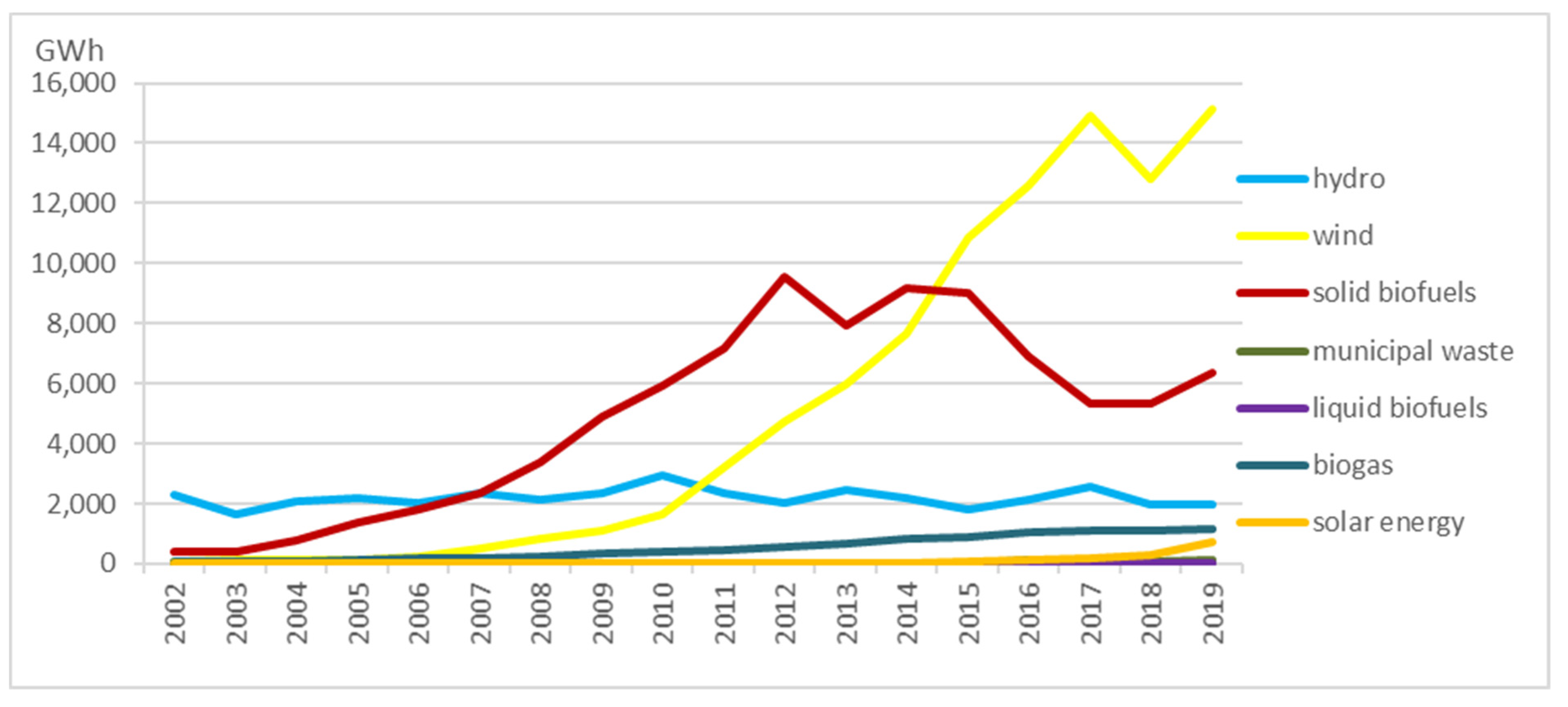
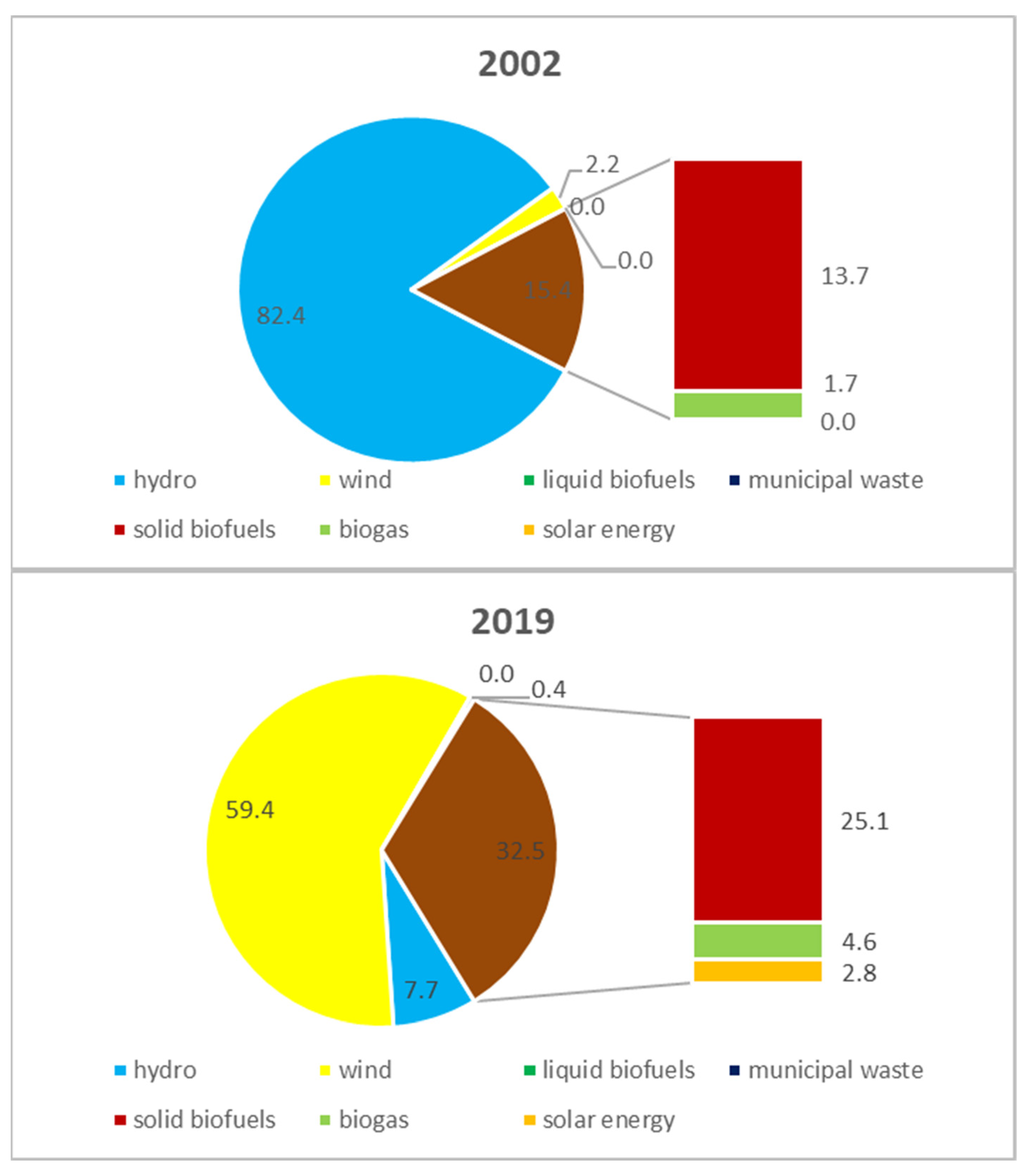
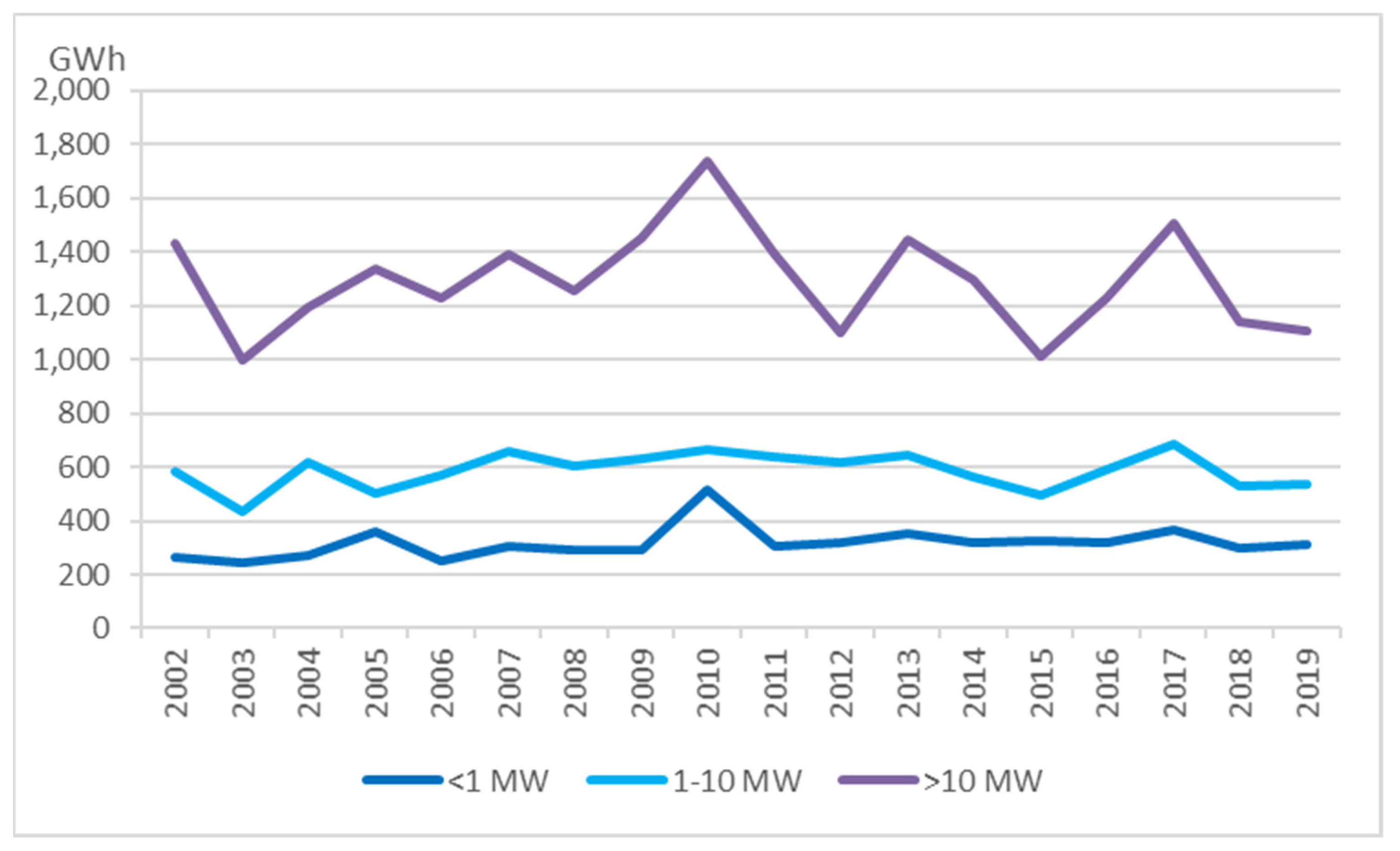
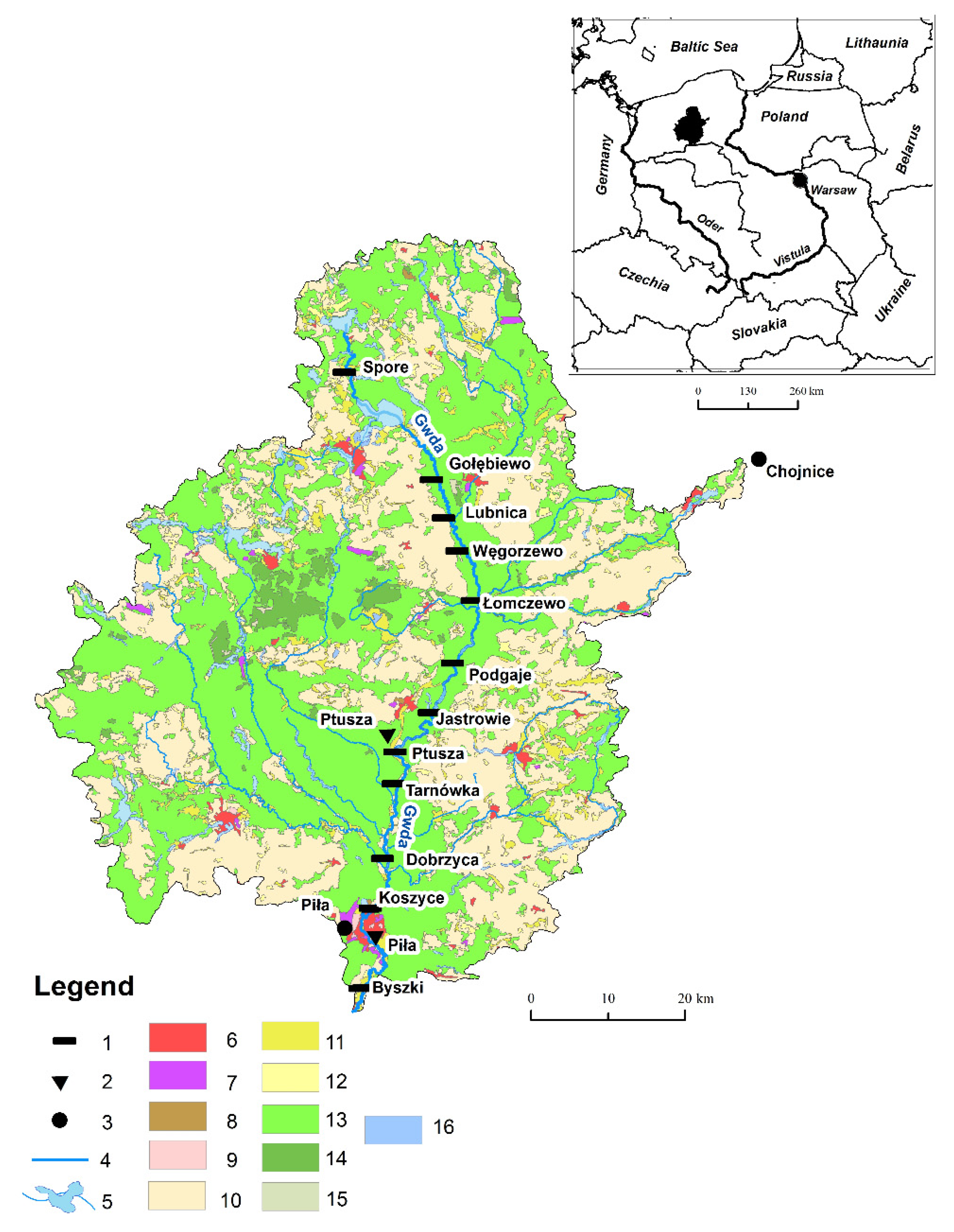
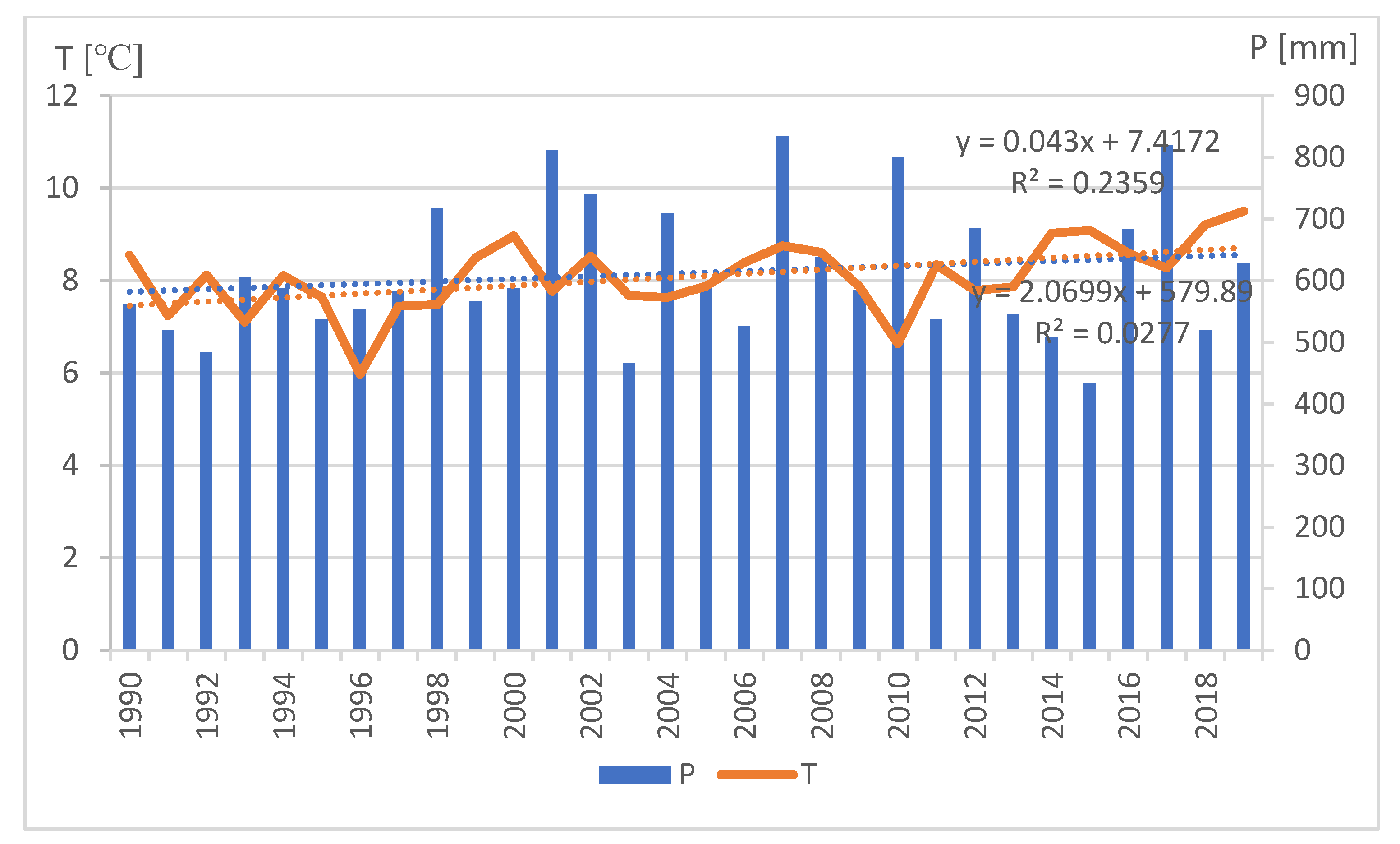
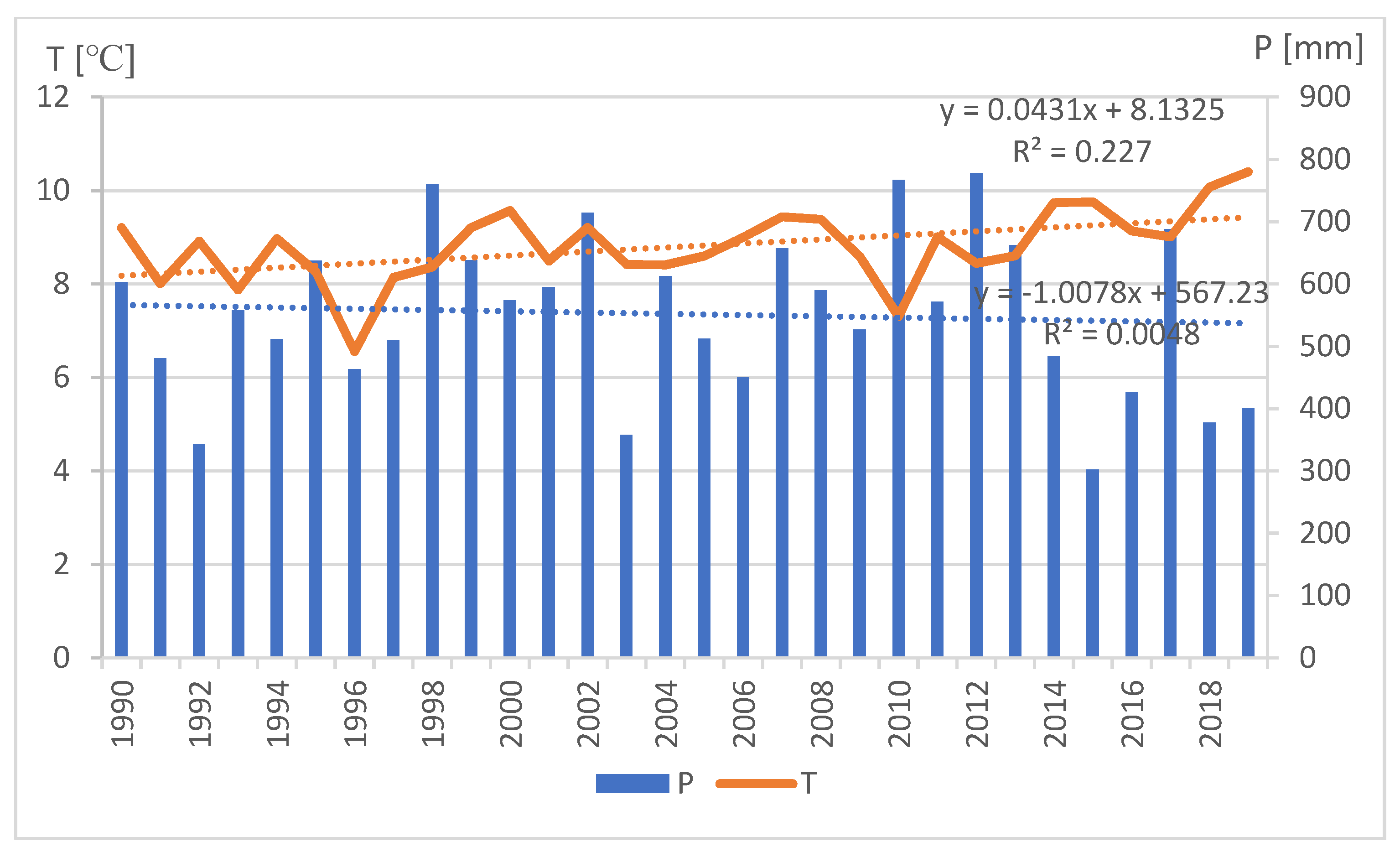

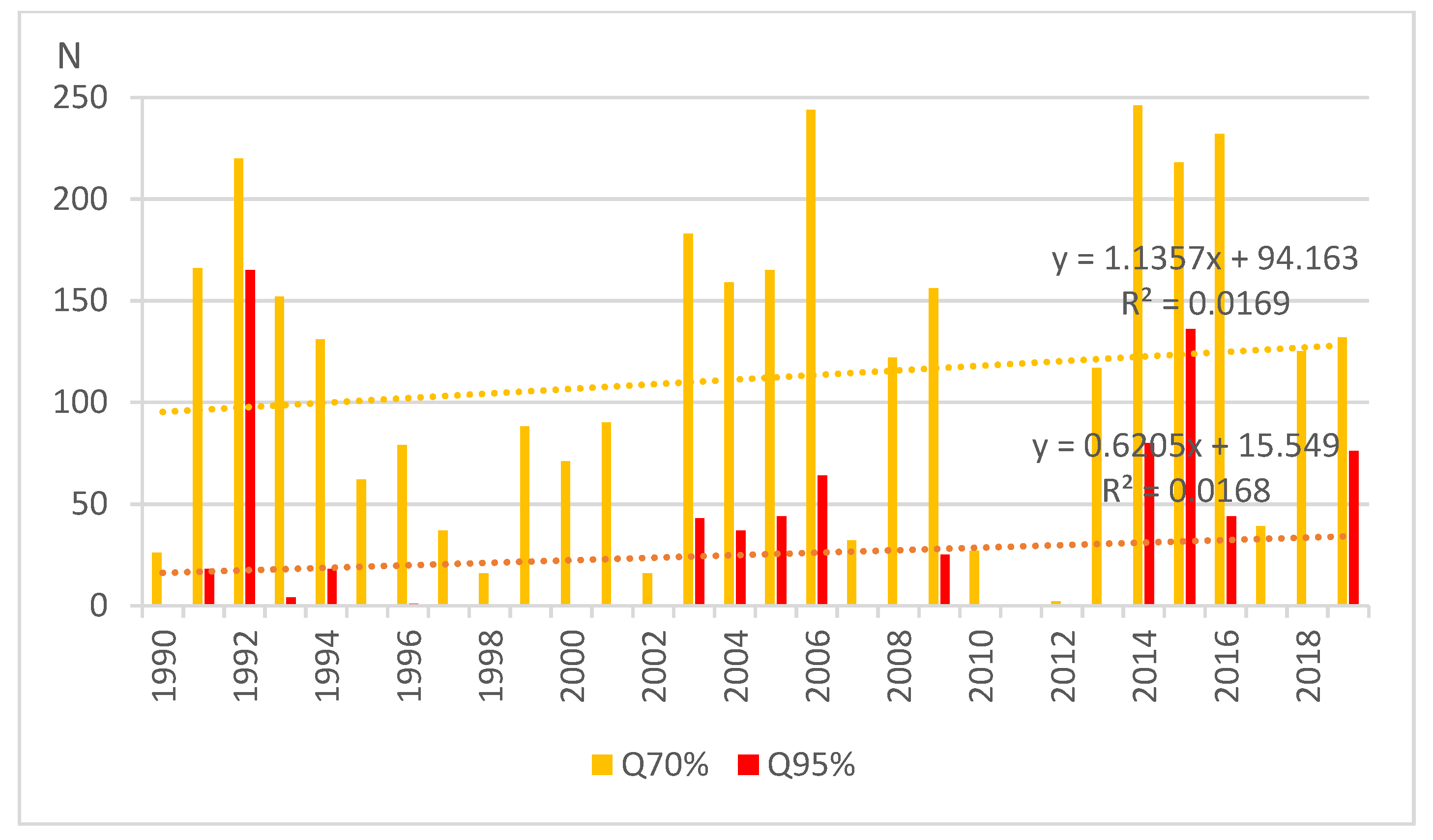

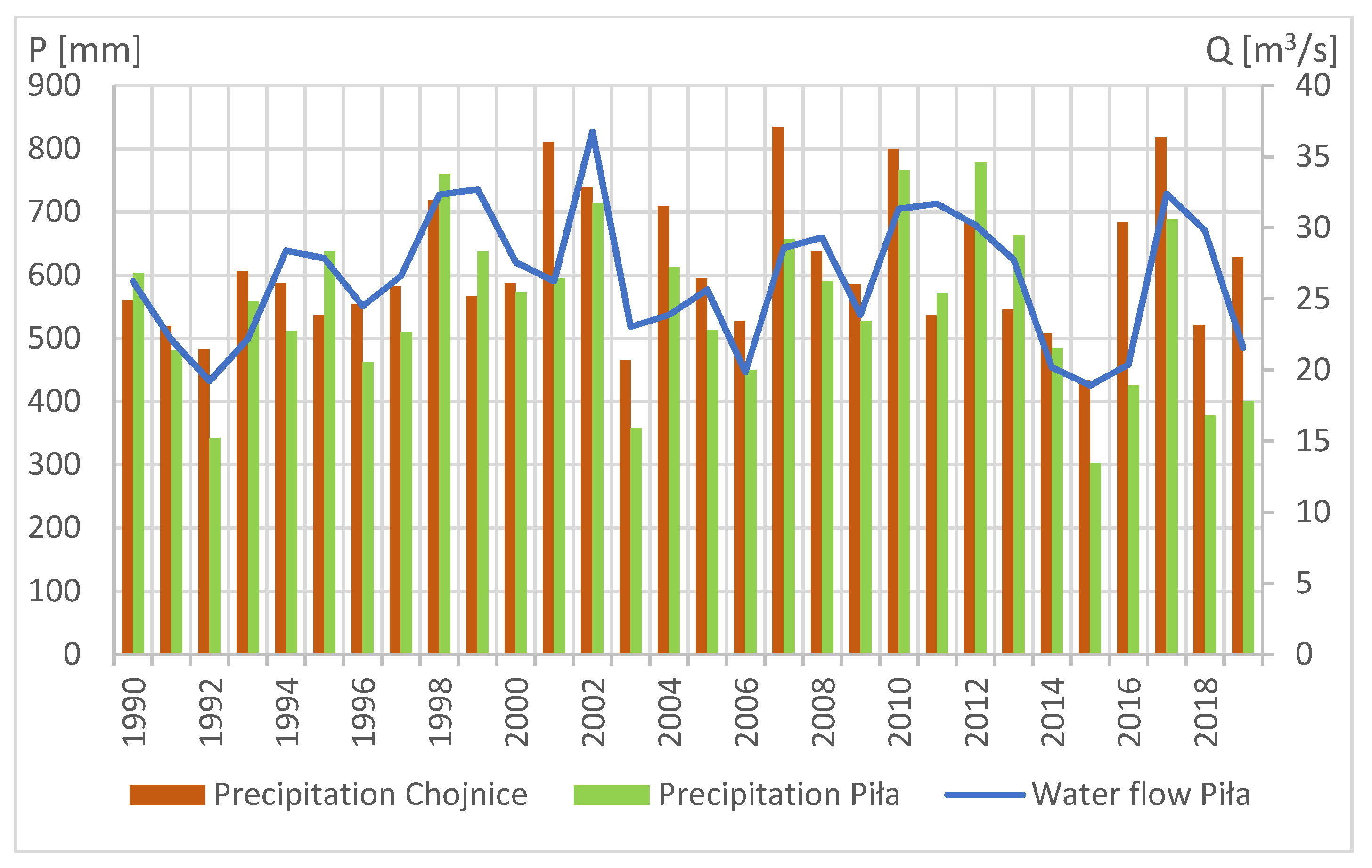
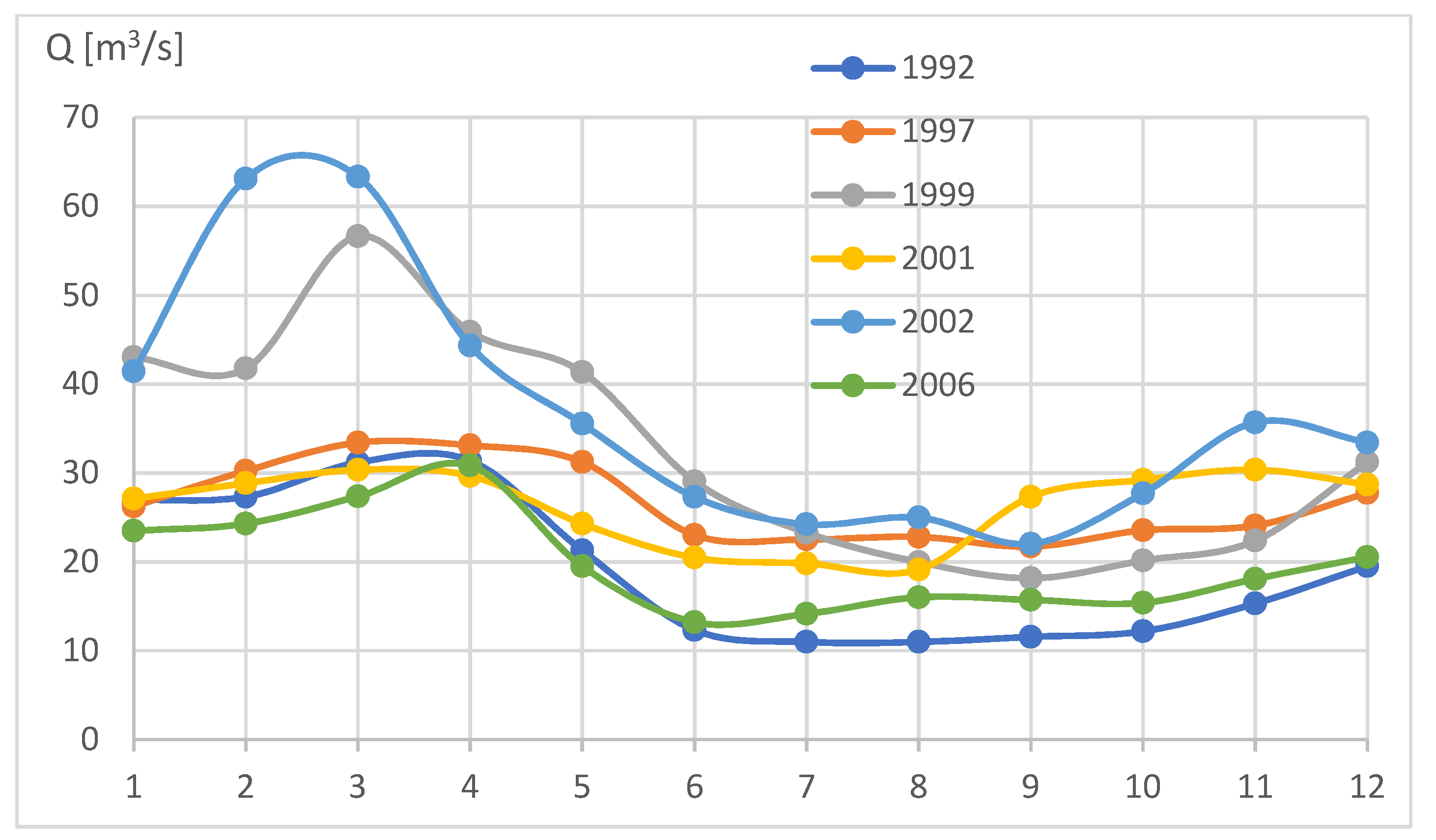


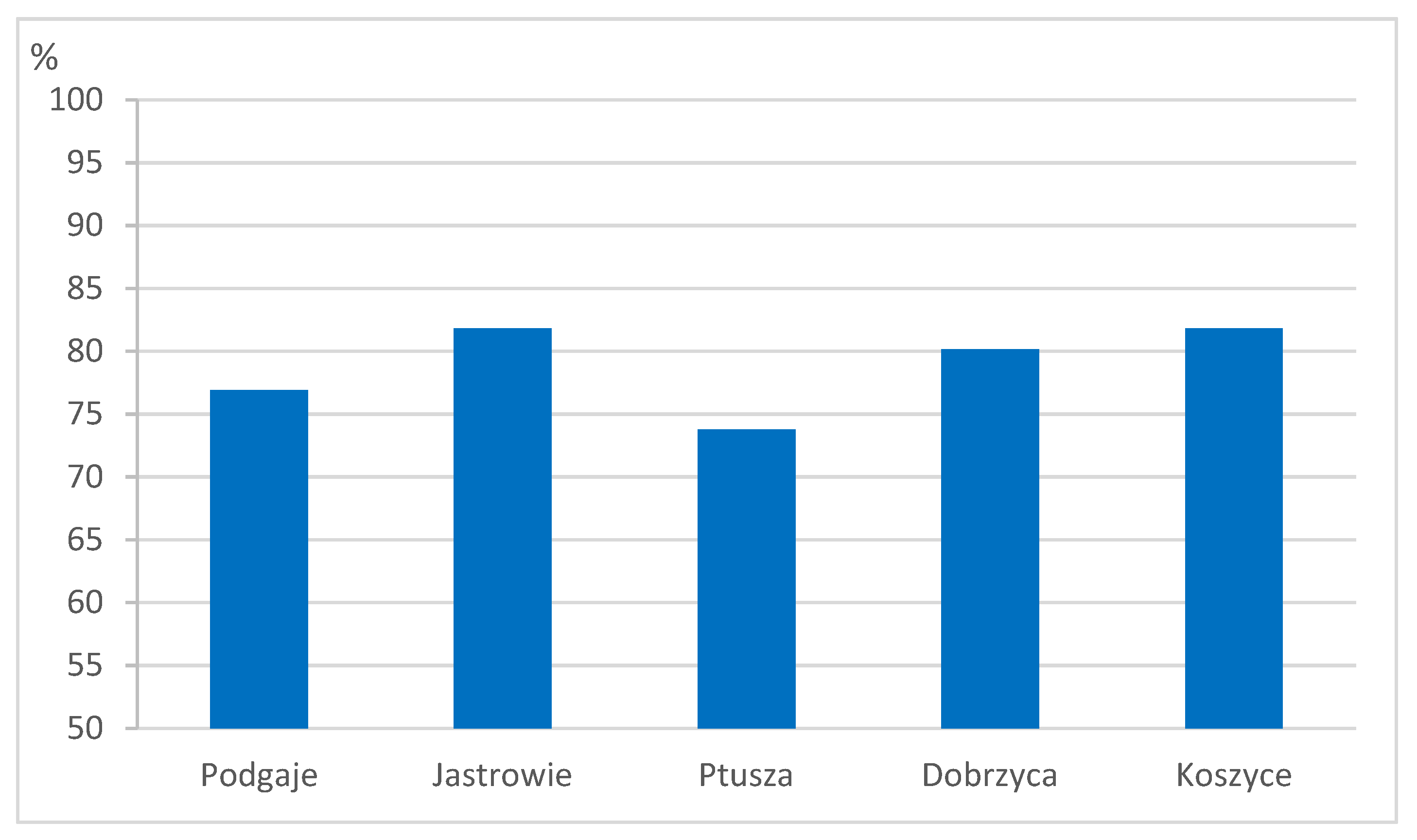
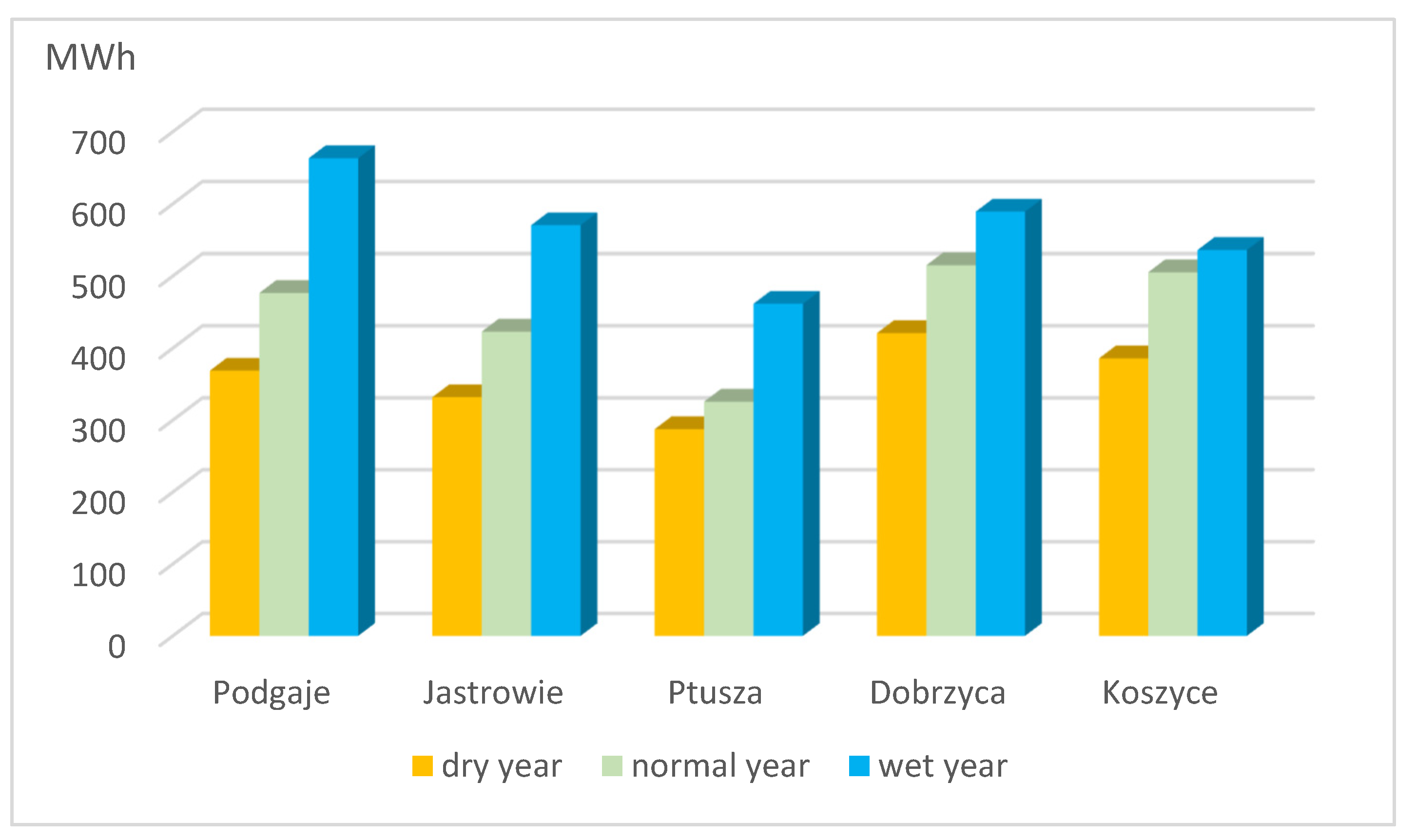
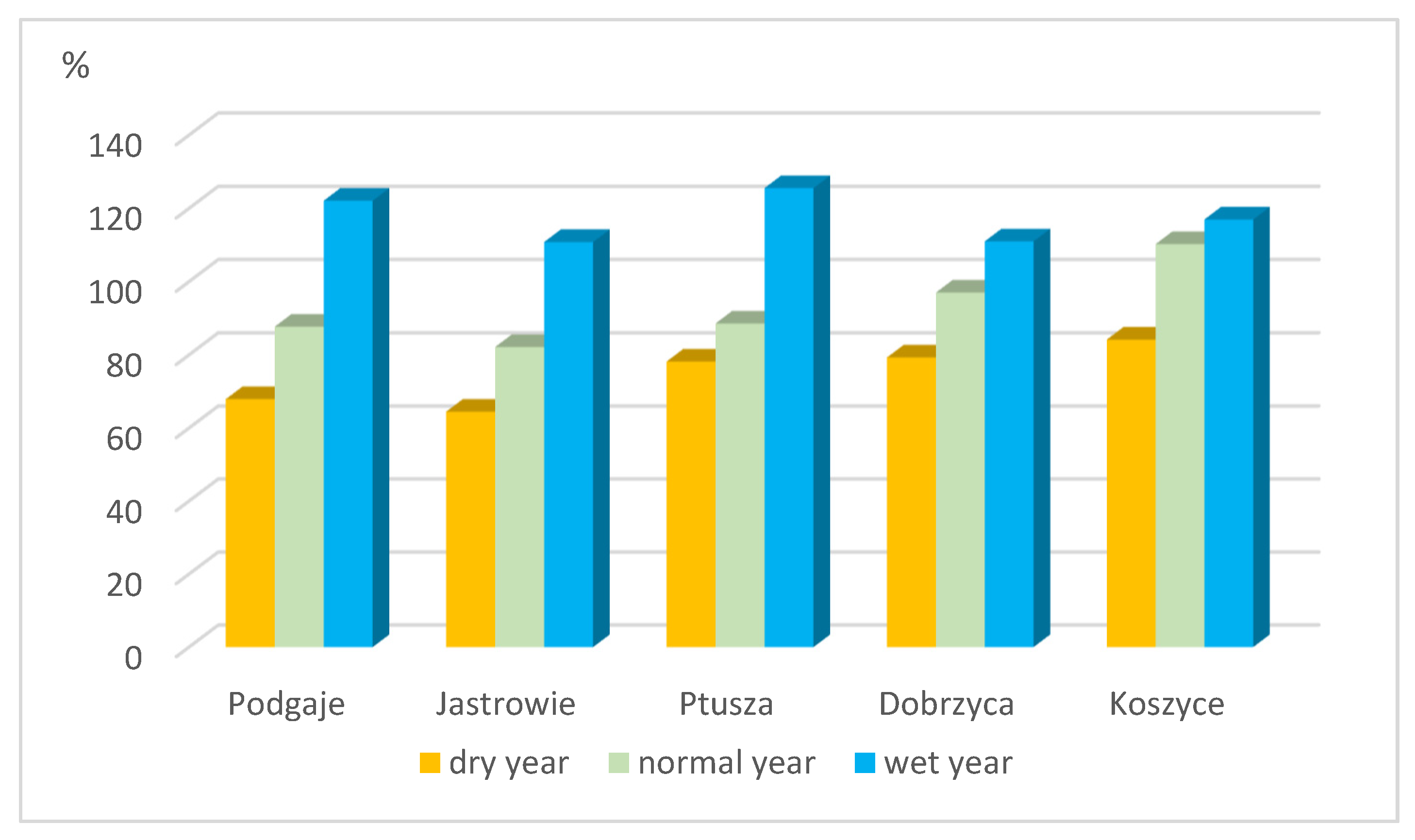
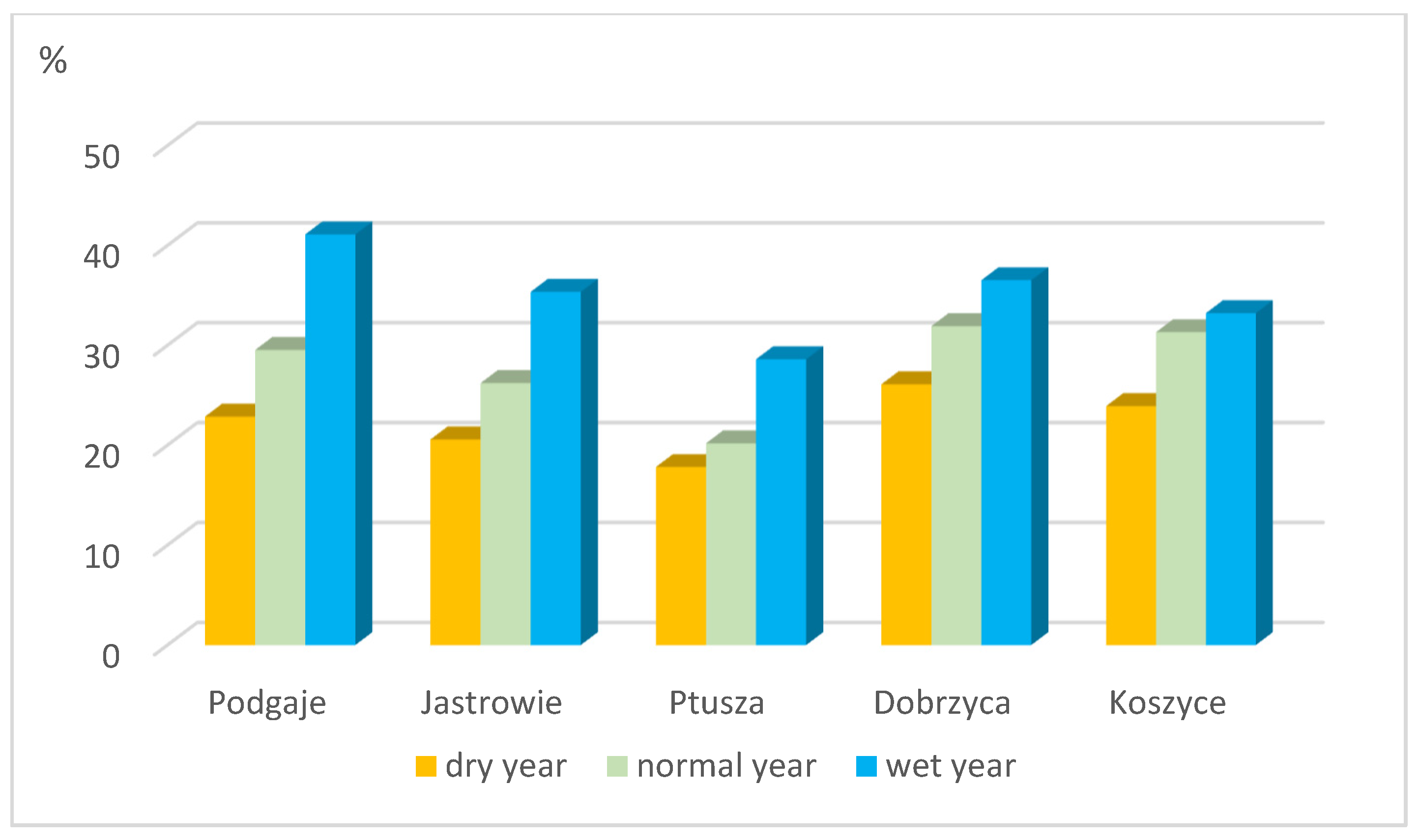
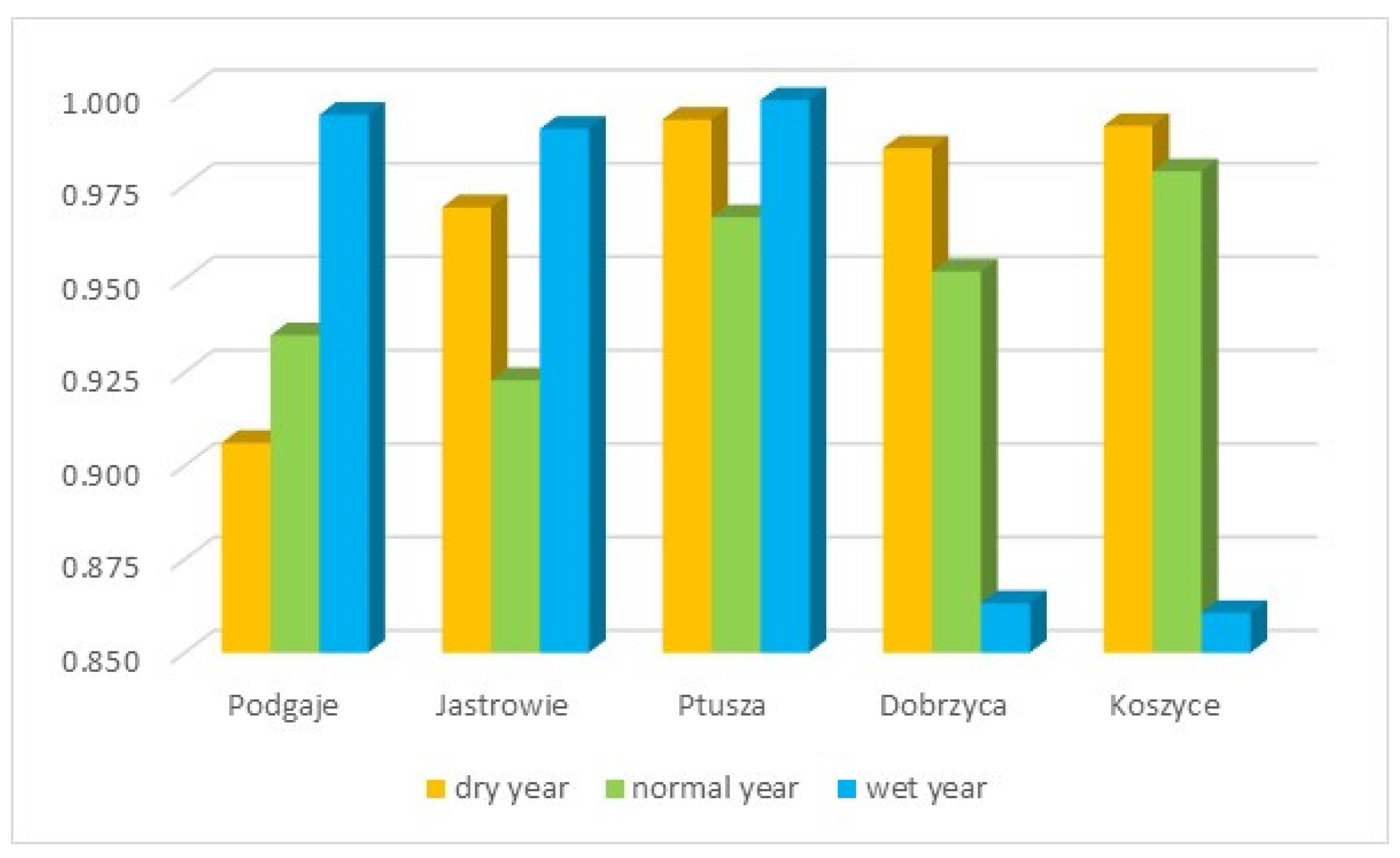
| SHP | Installed Power [kW] | Height of the Fall [m] | Average Flow [m3/s] | Average Electricity Generation [MWh/Year] |
|---|---|---|---|---|
| Podgaje | 2210 | 9.55 | 29.48 | 6519 |
| Jastrowie | 1720 | 7.20 | 30.44 | 6177 |
| Ptusza | 1310 | 6.10 | 27.40 | 4412 |
| Dobrzyca | 1350 | 4.80 | 35.84 | 6370 |
| Koszyce | 1140 | 3.55 | 49.14 | 5500 |
Publisher’s Note: MDPI stays neutral with regard to jurisdictional claims in published maps and institutional affiliations. |
© 2021 by the authors. Licensee MDPI, Basel, Switzerland. This article is an open access article distributed under the terms and conditions of the Creative Commons Attribution (CC BY) license (https://creativecommons.org/licenses/by/4.0/).
Share and Cite
Kubiak-Wójcicka, K.; Szczęch, L. Dynamics of Electricity Production against the Backdrop of Climate Change: A Case Study of Hydropower Plants in Poland. Energies 2021, 14, 3427. https://doi.org/10.3390/en14123427
Kubiak-Wójcicka K, Szczęch L. Dynamics of Electricity Production against the Backdrop of Climate Change: A Case Study of Hydropower Plants in Poland. Energies. 2021; 14(12):3427. https://doi.org/10.3390/en14123427
Chicago/Turabian StyleKubiak-Wójcicka, Katarzyna, and Leszek Szczęch. 2021. "Dynamics of Electricity Production against the Backdrop of Climate Change: A Case Study of Hydropower Plants in Poland" Energies 14, no. 12: 3427. https://doi.org/10.3390/en14123427
APA StyleKubiak-Wójcicka, K., & Szczęch, L. (2021). Dynamics of Electricity Production against the Backdrop of Climate Change: A Case Study of Hydropower Plants in Poland. Energies, 14(12), 3427. https://doi.org/10.3390/en14123427







